Fayette County, Texas
Fayette County is a county located in the U.S. state of Texas. As of the 2010 census, the population was 24,554.[1] Its county seat is La Grange.[2] The county was created in 1837 and organized the next year.[3]
Fayette County | |
|---|---|
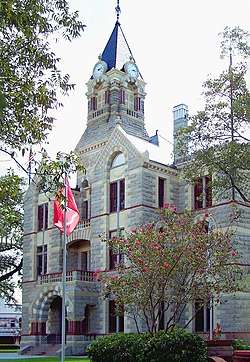 The current Fayette County Courthouse in La Grange was finished in 1891. The Romanesque Revival style building uses four types of native Texas stone to detail the exterior. | |
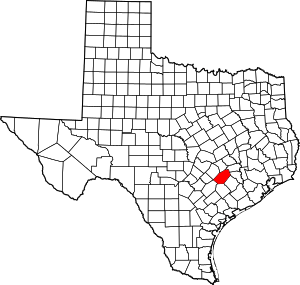 Location within the U.S. state of Texas | |
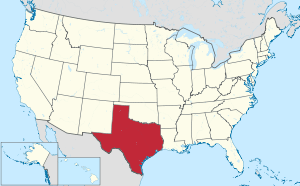 Texas's location within the U.S. | |
| Coordinates: 29°52′N 96°56′W | |
| Country | |
| State | |
| Founded | 1837 |
| Named for | Marquis de la Fayette |
| Seat | La Grange |
| Largest city | La Grange |
| Area | |
| • Total | 960 sq mi (2,500 km2) |
| • Land | 950 sq mi (2,500 km2) |
| • Water | 9.8 sq mi (25 km2) 1.0%% |
| Population (2010) | |
| • Total | 24,554 |
| • Density | 26/sq mi (10/km2) |
| Time zone | UTC−6 (Central) |
| • Summer (DST) | UTC−5 (CDT) |
| Congressional district | 10th |
| Website | www |
History
Fayette County was established in 1837 from land given by Bastrop and Colorado Counties. It is named for the Marquis de Lafayette, a French nobleman who became an American Revolutionary War hero.[4][5]
An early resident of Brazoria County and then Fayette County, Joel Walter Robison, fought in the Texas Revolution and served in the Texas House of Representatives.[6]
More than a dozen historic properties are listed on the National Register of Historic Places in Fayette County.
Fayette County is the location of the real Chicken Ranch, which was the basis of the musical play and feature film The Best Little Whorehouse in Texas.
Geography
According to the U.S. Census Bureau, the county has a total area of 960 square miles (2,500 km2), of which 950 square miles (2,500 km2) are land and 9.8 square miles (25 km2) (1.0%) are covered by water.[7]
Adjacent counties
- Lee County (north)
- Washington County (northeast)
- Austin County (east)
- Colorado County (southeast)
- Lavaca County (south)
- Gonzales County (southwest)
- Caldwell County (west)
- Bastrop County (northwest)
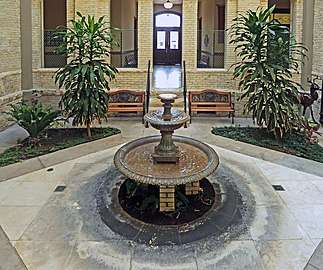
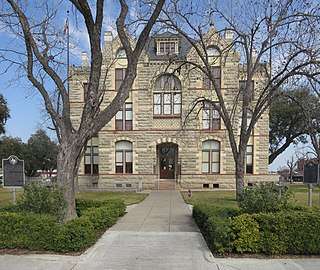

Demographics
| Historical population | |||
|---|---|---|---|
| Census | Pop. | %± | |
| 1850 | 3,756 | — | |
| 1860 | 11,604 | 208.9% | |
| 1870 | 16,863 | 45.3% | |
| 1880 | 27,996 | 66.0% | |
| 1890 | 31,481 | 12.4% | |
| 1900 | 36,542 | 16.1% | |
| 1910 | 29,796 | −18.5% | |
| 1920 | 29,965 | 0.6% | |
| 1930 | 30,708 | 2.5% | |
| 1940 | 29,246 | −4.8% | |
| 1950 | 24,176 | −17.3% | |
| 1960 | 20,384 | −15.7% | |
| 1970 | 17,650 | −13.4% | |
| 1980 | 18,832 | 6.7% | |
| 1990 | 20,095 | 6.7% | |
| 2000 | 21,804 | 8.5% | |
| 2010 | 24,554 | 12.6% | |
| Est. 2019 | 25,346 | [8] | 3.2% |
| U.S. Decennial Census[9] 1850–2010[10] 2010–2014[1] | |||
As of the census[11] of 2000, 21,804 people, 8,722 households, and 6,044 families resided in the county. The population density was 23 people per square mile (9/km²). The 11,113 housing units averaged 12 per square mile (5/km²). The racial makeup of the county was 84.58% White, 7.01% African American, 0.36% Native American, 0.22% Asian, 6.72% from other races, and 1.11% from two or more races. About 12.78% of the population were Hispanic or Latino of any race; 34.9% were of German, 16.4% Czech, 7.6% American, and 5.3% English ancestry according to Census 2000.
Christianity is the number-one religion and Judaism is the second.[12]
Of the 8,722 households, 28.50% had children under the age of 18 living with them, 58.00% were married couples living together, 7.80% had a female householder with no husband present, and 30.70% were not families. About 28.00% of all households were made up of individuals, and 16.40% had someone living alone who was 65 years of age or older. The average household size was 2.44 and the average family size was 2.97.
In the county, the population was distributed as 23.20% under the age of 18, 7.00% from 18 to 24, 23.60% from 25 to 44, 24.20% from 45 to 64, and 22.00% who were 65 years of age or older. The median age was 43 years. For every 100 females, there were 93.70 males. For every 100 females age 18 and over, there were 91.00 males.
The median income for a household in the county was $34,526, and for a family was $43,156. Males had a median income of $29,008 versus $20,859 for females. The per capita income for the county was $18,888. About 8.10% of families and 11.40% of the population were below the poverty line, including 12.70% of those under age 18 and 13.50% of those age 65 or over.
Transportation
Airport
The county owns Fayette Regional Air Center, in an unincorporated area west of LaGrange.
Major highways
.svg.png)







Media
Fayette County is home to three newspapers and two radio stations.
Newspapers
- Fayette County Record
- Schulenburg Sticker
- Flatonia Argus
Radio
- KVLG/KBUK
- KTIMe
Communities
Cities
- Carmine
- Fayetteville
- La Grange (county seat)
- Schulenburg
Unincorporated communities
- Ammannsville
- Armstrong
- Bethany
- Bridge Valley
- Buckner's Creek
- Burnham's Crossing
- Cedar
- Cistern
- Colony
- Dubina
- Ellinger
- Elm Grove
- Engle
- Floy
- Ford's Prairie
- Franke
- Freyburg
- Halsted
- High Hill
- Holman
- Hostyn
- Indian Creek
- Ingram's Prairie
- Joiner
- Kirtley
- Kocicina
- Ledbetter
- Lena
- Leevan
- Lewis Settlement
- Live Oak Hill
- Lyons
- Manton Spring
- Marly
- Mecklenburg
- Middle Creek
- Miller's Station
- Moravan
- Muldoon
- Mullins Prairie
- Nassau
- Navidad
- Nechanitz
- O'Quinn
- Oldenburg
- Orizaba
- Oso
- Park
- Pecan
- Pine Springs
- Plum
- Praha (formerly Mulberry)
- Prairie Valley
- Rabbs Prairie
- Rek Hill
- Rocky Ridge
- Ross Prairie
- Roznov
- Rutersville
- St. John
- Scott
- Sedan
- Stellar
- Swiss Alp
- Tamberg
- Toledo
- Waldeck
- Walhalla
- Warda
- Warrenton
- Wendt
- West Point
- Willow Springs
- Winchester
- Winedale
- Wood's Fort
- Wursten
- Zapalac
Ghost towns
- Biegel
- Black Jack Springs
- Bluff
- Gay Hill
- Haw Creek
- Pin Oak
- Stella
Politics
| Year | Republican | Democratic | Third parties |
|---|---|---|---|
| 2016 | 78.2% 8,743 | 19.2% 2,144 | 2.6% 287 |
| 2012 | 76.6% 8,106 | 21.9% 2,315 | 1.5% 160 |
| 2008 | 70.4% 7,582 | 28.0% 3,014 | 1.6% 169 |
| 2004 | 72.4% 7,527 | 27.0% 2,803 | 0.6% 67 |
| 2000 | 70.9% 6,658 | 27.1% 2,542 | 2.0% 187 |
| 1996 | 52.0% 4,195 | 38.7% 3,119 | 9.4% 754 |
| 1992 | 42.9% 3,789 | 33.1% 2,923 | 23.9% 2,111 |
| 1988 | 57.1% 4,551 | 42.5% 3,390 | 0.4% 30 |
| 1984 | 70.4% 5,711 | 29.3% 2,379 | 0.3% 22 |
| 1980 | 60.3% 4,104 | 38.1% 2,590 | 1.6% 110 |
| 1976 | 46.7% 3,030 | 52.8% 3,428 | 0.5% 35 |
| 1972 | 73.4% 3,882 | 26.5% 1,400 | 0.2% 9 |
| 1968 | 41.2% 2,380 | 31.7% 1,833 | 27.1% 1,562 |
| 1964 | 35.9% 2,036 | 63.9% 3,630 | 0.2% 11 |
| 1960 | 38.8% 2,213 | 60.8% 3,462 | 0.4% 24 |
| 1956 | 60.5% 3,574 | 38.7% 2,282 | 0.8% 48 |
| 1952 | 62.4% 4,240 | 37.6% 2,557 | 0.0% 3 |
| 1948 | 32.8% 1,737 | 58.6% 3,106 | 8.6% 455 |
| 1944 | 26.7% 1,611 | 52.3% 3,156 | 21.0% 1,263 |
| 1940 | 48.3% 2,441 | 51.6% 2,606 | 0.1% 5 |
| 1936 | 17.4% 595 | 82.5% 2,820 | 0.2% 5 |
| 1932 | 4.7% 245 | 95.3% 4,985 | 0.1% 3 |
| 1928 | 15.9% 689 | 84.0% 3,647 | 0.1% 5 |
| 1924 | 22.5% 1,450 | 59.7% 3,851 | 17.9% 1,154 |
| 1920 | 24.3% 1,101 | 20.6% 932 | 55.1% 2,494 |
| 1916 | 38.4% 1,212 | 60.2% 1,902 | 1.5% 46 |
| 1912 | 17.2% 461 | 74.8% 2,011 | 8.0% 215 |
See also
References
- "State & County QuickFacts". United States Census Bureau. Archived from the original on June 6, 2011. Retrieved December 16, 2013.
- "Find a County". National Association of Counties. Archived from the original on May 3, 2015. Retrieved 2011-06-07.
- "Texas: Individual County Chronologies". Texas Atlas of Historical County Boundaries. The Newberry Library. 2008. Retrieved May 23, 2015.
- Gannett, Henry (1905). The Origin of Certain Place Names in the United States. Govt. Print. Off. p. 124.
- Alvarez, Elizabeth Cruce (Nov 8, 2011). Texas Almanac 2012–2013. Texas A&M University Press. pp. Contents. ISBN 9780876112571. Retrieved 17 November 2013.
- "Robison, Joel Walter". Texas State Historical Association. 2010-06-15. Retrieved August 2, 2015.
- "2010 Census Gazetteer Files". United States Census Bureau. August 22, 2012. Retrieved April 26, 2015.
- "Population and Housing Unit Estimates". United States Census Bureau. May 24, 2020. Retrieved May 27, 2020.
- "U.S. Decennial Census". United States Census Bureau. Retrieved April 26, 2015.
- "Texas Almanac: Population History of Counties from 1850–2010" (PDF). Texas Almanac. Retrieved April 26, 2015.
- "U.S. Census website". United States Census Bureau. Retrieved 2011-05-14.
- Wilson, Reid. The second-largest religion in each state, Washington Post, June 4, 2014.
- Leip, David. "Dave Leip's Atlas of U.S. Presidential Elections". uselectionatlas.org. Retrieved 6 April 2018.
External links
| Wikimedia Commons has media related to Fayette County, Texas. |
- Fayette County government's website
- Fayette County, Texas from the Handbook of Texas Online
- Historic materials from Fayette County, hosted by the Portal to Texas History
